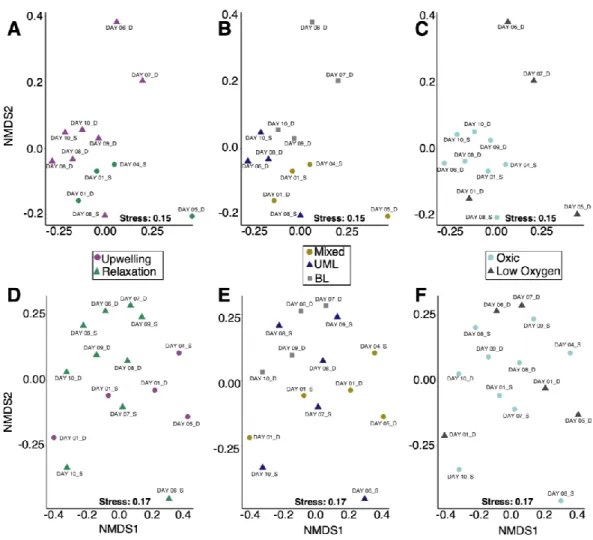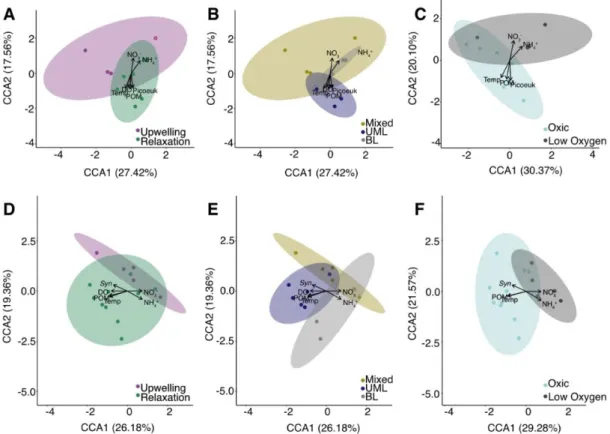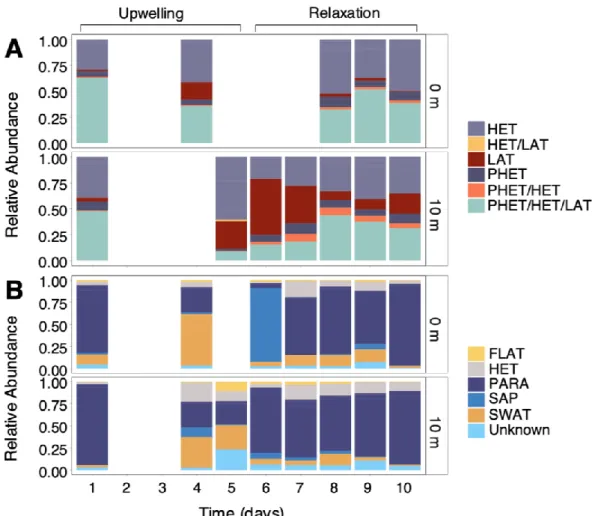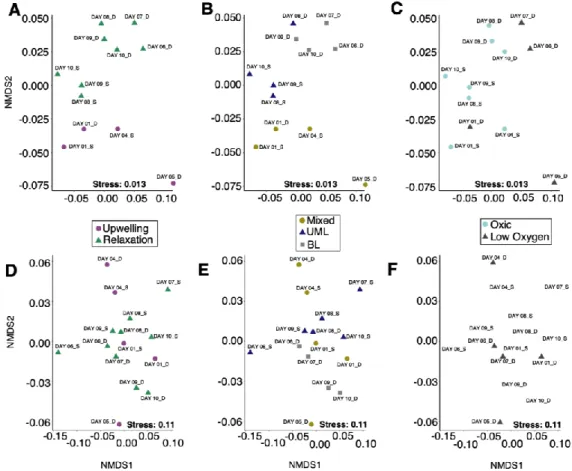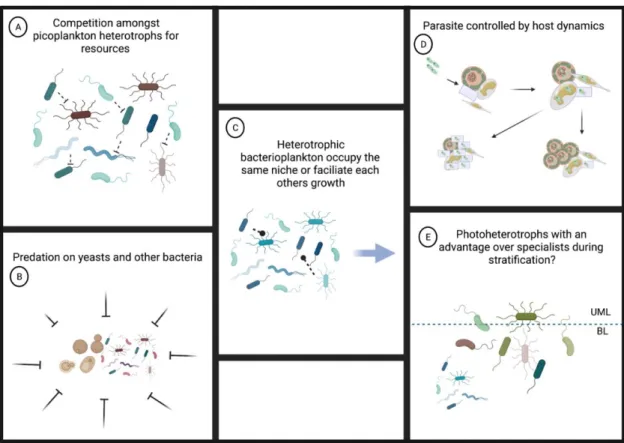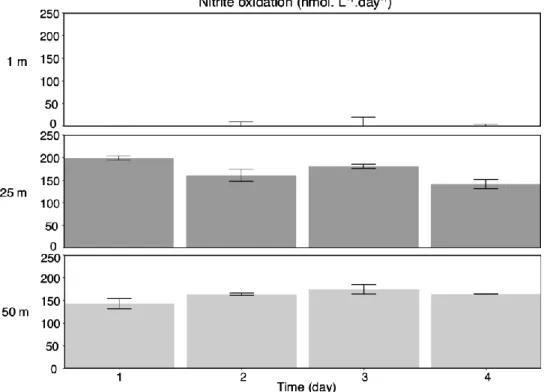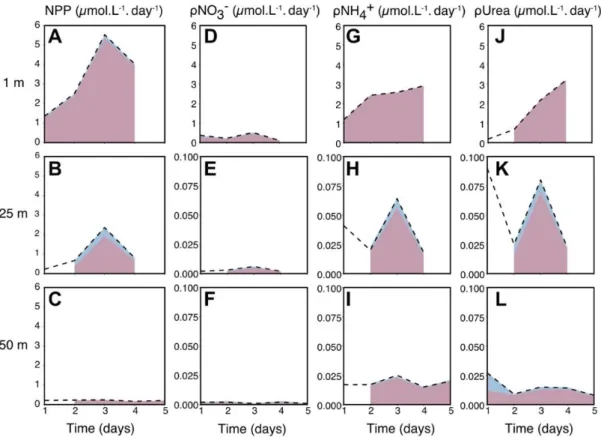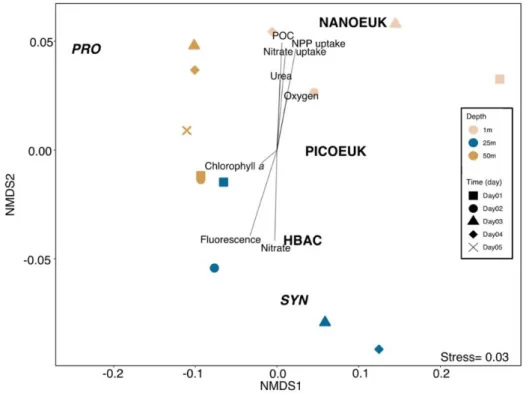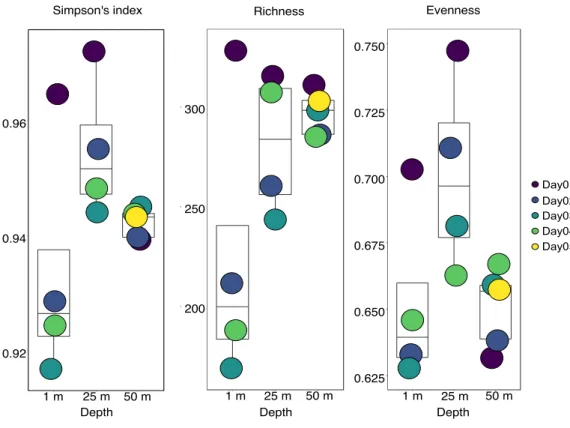Thank you for your invaluable advice and guidance not only in academics but also in life. Thanks to Pieter Truter, Andre du Randt and Lisa Mansfield for the support at sea. Thank you for the support, the love and the random weekend visits to Cape Town that made me miss home less.
You are the best friend, the best mother and the most motivating person I know, thank you.
Chapter 1: General Introduction
Diatoms, chrysophytes, pelagophytes, dictyochophytes and bolidophytes are also well represented in the databases (Vaulot et al., 2008). The environmental factors controlling primary production in the euphotic zone, adapted from Boyd et al. One of the most important biogeochemical cycles in the ocean is that of nitrogen (Figure 1.2).
Microbial composition during the upwelling season has been studied in the bay (Rocke et al., 2020); however, the nuances in everyday life.
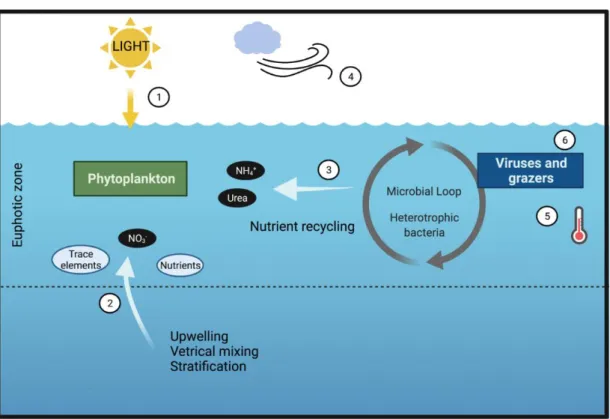
Chapter 2: Variability in picoplankton dynamics during an upwelling cycle in the
These water column classifications were determined from hydrographic data in Burger et al. Comparisons between log-transformed abundances of the top 30 bacterioplankton families (class and species data in Table S2). Helena Bay supports much of the primary production of the southern Benguela lift system (Brown et al., 1991; Flynn et al., 2018).
Helena Bay causes diversification in the bacterioplankton community compared to surface waters (Pitcher et al., 2014). There was a notable decrease in richness at the surface on day 7, coinciding with a decrease in available macronutrients due to the growth of nanophytoplankton (Burger et al., 2020). Helena Bay, which found Dino-Group-II represented 26% of the entire data set, while Dino-Group-I represented only 12% (Rocke et al., 2020).
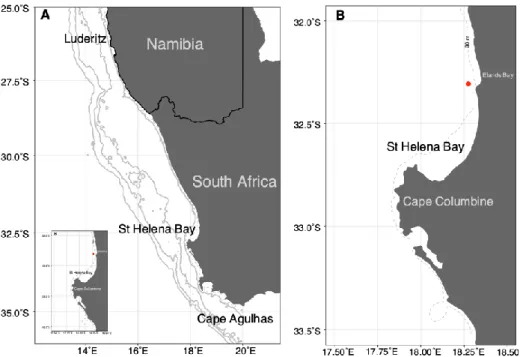
Chapter 3: Short-term dynamics of nano-picoplankton production during autumn
Prochlorococcus is the smallest and most abundant photosynthetic organism in the world (Partensky et al., 1999b). They are often abundant in the nutrient-rich areas in the euphotic zone of the ocean (Partensky et al., 1999a; Moore et al., 2002). In summer, primary production in the SBUS is dominated by new production, due to wind-driven upwelling of remineralized nutrients (Burger et al., 2020).
These findings are consistent with a previous study done during winter in southern Benguela (Flynn et al., 2018). Remineralized nutrients were found trapped on the southern Benguela shelf during summer to winter (Flynn et al., 2020). The higher chlorophyll values below the MLD are most likely submerged cells, not degraded by the high biomass found on the surface on day 1 (Wassmann et al., 1990).
Deepening of the upper mixed layer on the second day introduced nitrate from depth to the surface, stimulating growth (Lamont et al., 2014). Picoplankton includes heterotrophic bacteria, which are responsible for recycling organic matter in the euphotic zone (Azam et al., 1983; Stockner, 1988). Significant rates of heterotrophic assimilation of inorganic nitrogen have previously been observed during phytoplankton blooms in other parts of the world (Kirchman, 1994) and in southern Benguela (Flynn et al., 2018).
Helena Bay (Flynn et al., 2018) and may be the same reason for the high C:N ratio in this study. During wind-driven upwelling, when nutrients are supplied to the surface, Synechococcus is often highly abundant (Bergo et al., 2017);

Chapter 4: Depth-differentiated nano-picoplankton dynamics during five days in
Eastern boundary upwelling systems support much (>20%) of the world's fish catch due to the eutrophic nature of these coastal areas (Croll et al., 2005). Further analysis of the classified taxa was performed using the phyloseq package (McMurdie and Holmes, 2013) in R (R Core Team, 2013). The majority (46%) of the total classified sequences in this study belonged to the Proteobacteria (Figure 4.4).
Flavobacteriales were the most common order in the study, accounting for 27% of all top reads. None of the eukaryotic orders identified in this study showed a preference for any depth (Tables 4.3 and 4.4). Cell color refers to the normalized abundance (%) of the pathway/gene in the sample, ranging from minimum (blue) to maximum (red).
Particulate organic matter was an important factor related to the potential functionality of the taxa at 50 m. Nitrite oxidation rates and the relative abundance of the genes associated with the nitrite oxidation pathway were greater at depth (Figure 4.6). Although much of the uptake of nitrogen occurred at the surface (Chapter 3), the cycling and transformation of nitrogen occurred mainly at 25 m and 50 m during this study.
Nitrospinales are ubiquitous nitrite-oxidizing bacteria in the global ocean and play an important role in carbon fixation, especially in dark parts of the ocean (Pachiadaki et al., 2017). The importance of nutrient profiles and uptake rates in the water column was discussed in Chapter 3.
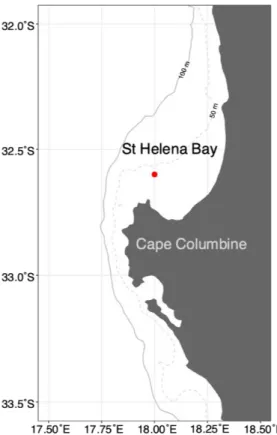
Chapter 5: Synthesis
Physical separations in the water column thus created distinct bacterioplankton communities; however, the same could not be said for picoeukaryotes. It was found in this thesis that on a daily time scale there is a strong physical-biological coupling in the small plankton, in both upwelling and post-upwelling season. Furthermore, I confirmed that the position of taxa in the water column is linked to their metabolic potential in the context of the surrounding environment.
Based on the data obtained during this thesis, it is concluded that the short-term dynamics of picoplankton and nano-picoplankton under the described environmental conditions is primarily controlled by physical variability in the water column. These are some of the first studies to analyze daily changes in picoplankton and nano-picoplankton in southern Benguela, contributing to the recent surge in marine microbial ecology research occurring in the coastal waters around South Africa. Therefore, I needed an alternative method to get a more accurate representation of the diversity present in the metagenomes.
The comparison of different time scales can explain more about the ecosystem functioning of the picoplankton and nano-picoplankton in the southern Benguela. Changes in the virus community composition and structure on a daily time scale in coastal waters will be an important future step in this research. Nitrogen cycling is an ongoing focus of much of the coastal research currently taking place in southern Benguela.
Finally, the expansion of low oxygen zones is an ongoing concern in productive regions, including in southern Benguela. Studying alternative electron acceptors (sulfur, methane, nitrate) for respiration in the low oxygen waters of southern Benguela, often found at the sediment-water column interface, would be an interesting research topic to pursue.
Supplementary Materials
Corresponding traits used to assign function in the 46 major families of Picoeukaryotes, adapted from marine protist source functional traits (Ramond et al. 2018). Functional group assignments of the 46 major families of picoeukaryotes based on trait assignments in Table S2.2. Saccharomycetales Saprophytic and/or parasitic Cystobasidiomycetes Saprophytic and/or parasitic Exobasidiomycetes Saprophytic and/or Parasitic Agaricomycetes Saprophytic and/or Parasitic Eurotiomycetes Saprophytic and/or Parasitic.
Gymnodiniaceae Swimming phototrophic and/or mixotrophic Mamiellaceae Swimming phototrophic and/or mixotrophic Chrysochromulinaceae Swimming phototrophic and/or mixotrophic Cryptomonadales_X Swimming phototrophic and/or mixotrophic Chlorellales_X Swimming phototrophic and mixotrophic and mixed phototrophic/mixotrophic and Pharophys otrophic Pedinellales Swimming phototrophic and/or mixotrophic Noelaerhabdaceae Swim mning phototrophic and/or mixotrophic Dolichomastigaceae Swimming phototrophic and/or mixotrophic Chrysophyceae_Clade-C Swimming phototrophic and/or mixotrophic Prasiolales_X Swimming phototrophic and/or mixotrophic Chrysophyceae_Clade-H Swimming phototrophic_ or mixotrophic_classified. Differential abundance of the top 30 bacterioplankton families was determined using DESeq2 between the active upwelling and relaxation periods. Results of single-factor ANOVAs comparing means of variables across three depths for 1) inorganic and organic matter concentrations, 2) uptake rates, 3) cell amounts, 4) carbon biomasses, and 5) nitrogen biomasses.
Results of single-factor ANOVAs comparing mean values of variables across sampling days, separated into the three depths, for 1) concentrations of inorganic and organic matter, and 2) uptake rates. Results of single-factor ANOVAs comparing mean values of variables across sampling days, separated into the three depths, for 1) cell abundances, 2) carbon biomasses, and 3) nitrogen biomasses. Results of Tukey multiple comparison tests showing probability values for pairwise comparisons between different depths for mean values of variables showing 1) concentrations of inorganic and organic matter, 2) uptake rates, 3) cell abundances, 4) carbon biomasses and 5) nitrogen biomasses.
The red triangles in Fig. A show the mixed layer depth (MLD) and in Fig. B the depth of the euphotic zone (Zeu) on each day of the experiment. Number of starting contigs, number of contigs after quality control, GC content (% Stdev), number of contigs with predicted coding reads and InterPro matches in each of the 13 metagenomes.
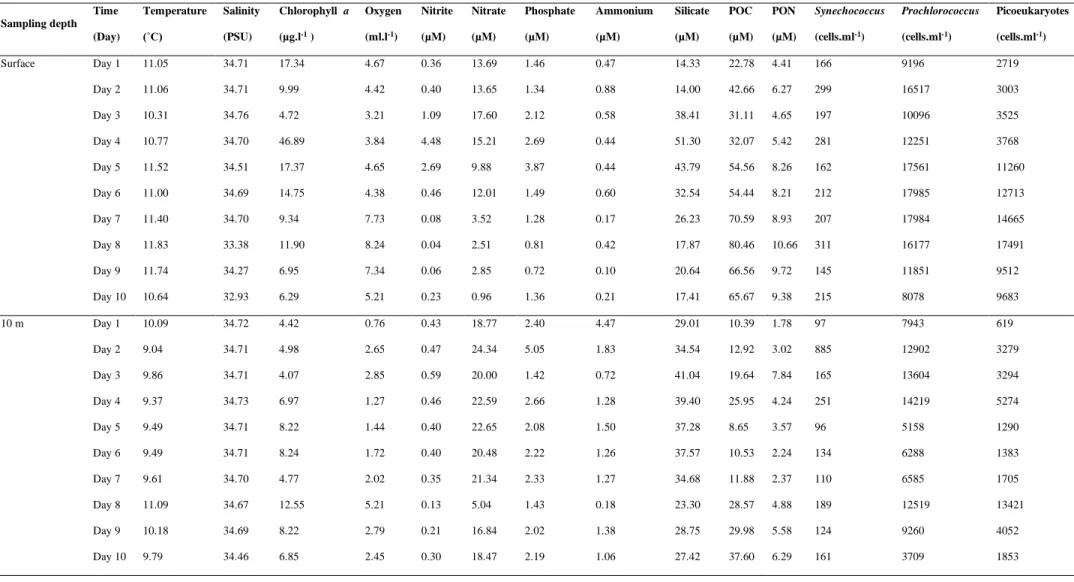
Nitrite oxidation in the upper water column and oxygen minimum zone of the eastern tropical North Pacific. The partitioning of carbon biomass between the pico- and nano-plankton community in the South Brazilian bay during a strong summer intrusion of South Atlantic Central Water. An Introduction to the Family Flavobacteriaceae,” in The Prokaryotes: Volume 7: Proteobacteria: Delta, Epsilon Subclass, ed.
The Family Cryomorphaceae,” in The Prokaryotes: Other Major Lineages of Bacteria and The Archaea, eds. Cross-chapter box on net primary production in the sea.” in: Climate Change 2014: Impacts, Adaptation and Vulnerability. Inorganic and organic nitrogen uptake by phytoplankton and heterotrophic bacteria in the stratified Mid-Atlantic Bight.
Estimates of phytoplankton and bacterial biomass and production in the northern and southern Benguela ecosystems. Horizontal transport and the distribution of nutrients in the coastal transition zone off northern California: effects on primary production, phytoplankton biomass, and species composition. Daily variation in the prokaryotic community during a spring bloom in shelf waters of the East China Sea.
Microbial abundance and activity in the seasonal upwelling area off Concepción (~36°S), central Chile: A comparison of upwelling and non-upwelling conditions. Oxygen at nanomolar levels reversibly suppresses process rates and gene expression in anammox and denitrification in the oxygen minimum zone off northern Chile.
